Yesterday was October 9 - and we marked that auspicious date with activities around nanotech, since that crucial unit of scale, a nanometer, represents 10-9 or one billionth of a meter, just below what the naked human eye can visualize.
We celebrated MIT.nano's three main facilities -- Characterization, Fabrication, and Immersion Lab -- where our people work on nanoscale projects and explore that tiny world, with big ramifications for the larger one that we practically live in.
In that celebration, we traveled through time - from the medieval times when humans used the nanoscale unwittingly (in processes like glasswork) to the modern day when nanomaterials show great promise in healthcare, construction, and elsewhere. And we arrived here, in the AI age - where artificial intelligence guides so much of our ground-breaking research on molecular and atomic levels, down in that nano-world where we need specialized tools to go.
One of the most fundamental ways that AI research has changed our world at the nanoscale is in inspecting biological systems.
It's not a coincidence, in that sense, that a trio of scientists won a recent nobel prize for Alphafold, the process of developing protein science with AI. And then there's the major body of work using AI to evaluate the human brain, a masterpiece of biology that provides the "inspiration" for what AI entities are doing. Like the brain, these systems use neurons (digital ones, in their case) to fire messaging through the network and provide "thinking" results.
One of our 10-9 day resources revealed that the human brain is estimated to have some 86 billion neurons. The writer characterized that as about four times the number of circuits in an Apple M4 chip, asking: can 4 Apple chips work as well as the human brain?
I concur with how this person answered their own question: not yet, because of the complexity of the brain. However, we are getting there in leaps and bounds - we're using AI (or it is using us) and we're doing a lot of the research at the nanoscale, deep inside of our "grey matter."
Another wide application of AI, researchers show us, is in replicating human senses. First, there's vision: if we can build AI to help us to see things at an atomic or cellular level, we get a trove of useful information about how medicine works, etc.
Then there's smell, where tiny nanoscale receptors or "nanoreceptors" function as the messengers, bringing us the signals that we translate into "yum" or "yuck" or whatever else an aroma inspires.
"Can robots smell?" ask the MIT people publishing our little book on nano and AI. "They could if they had a nose. We can build them one. Nature gave us a built-in nano-detector in our nose, but nanoscientists and nanoengineers are working to create man-made synthetic nano-detectors of smell. These are known as the artificial nose, and can help robots record and respond to the scents that surround them."
To be fair, the same writers also ask: can insects smell? and: can bananas smell? With interesting results.
To me, there's no example of nanomaterials quite like sunscreen.
The popular use of sunscreen is about as old, substantially, as World War II, although ancient civilizations reportedly had their own balms and ointments for skin protection. But your garden-variety SPF is only so effective against the catalysts of melanoma, unlike new projects that really bring nanoscience to building coatings for the skin that keep the tiny instigators out. Check out some of the science on zinc oxide and titanium oxide as active ingredients in a new line of sunscreens that will prevent your skin frying, flaking and flaring up under the sun.
"The sunscreen industry, like many others, is being transformed by artificial intelligence (AI), reshaping how products are developed, tested, and marketed," writes Torry Mastery at Dotcom magazine. "AI in the sunscreen industry is enabling the creation of more effective, personalized, and sustainable sunscreen solutions. From AI-powered formulations to consumer skin analysis, AI is improving the overall efficiency of sunscreen products and ensuring better protection against harmful UV rays. As the demand for personalized skincare solutions increases, AI is providing valuable insights that help sunscreen brands deliver products tailored to individual needs."
So that's going to really save lives, outside of the hospital, and help us feel better about one of our favorite pastimes - laying in the sun. There's something healing about getting your vitamin D, as long as it’s safe.
All of this and so much more came out of this year's 10-9 celebration. Take a minute to think about the contributions of this kind of science in our research communities. AI is supercharging what we know about the nanoscale.
